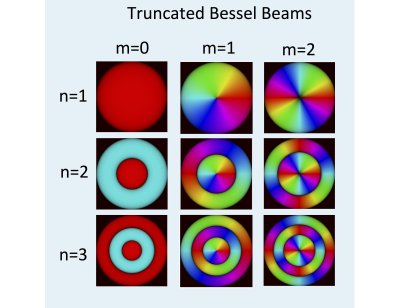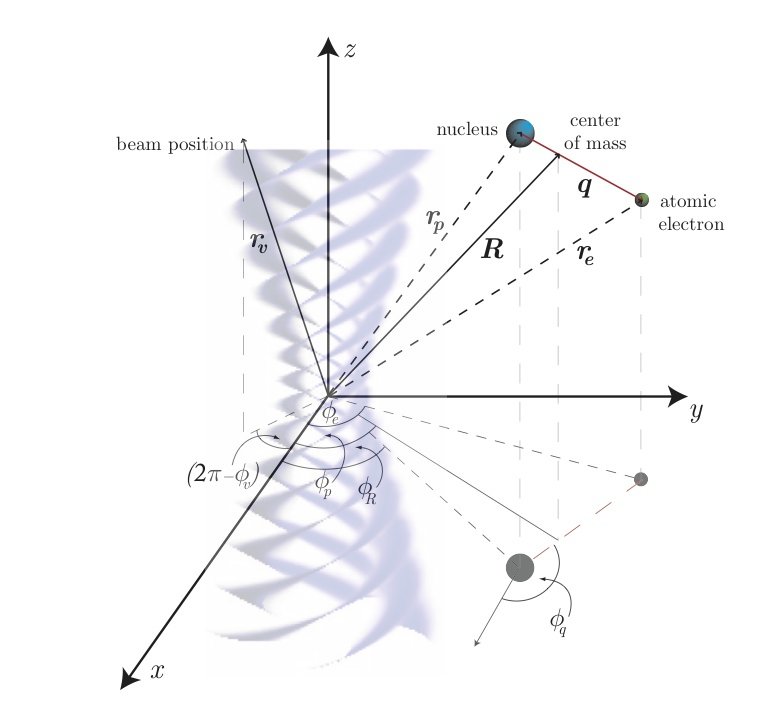Physics of electron vortex beams and wavefunction engineering
An electron vortex refers to a topological defect in the electron wavefunction where the phase is indeterminate and is associated with the orbital angular momentum as a property of such a state of the electrons. Research at York, is being carried out, both experimental and theoretical, on electron vortex beams, their interactions and applications. This is led by Prof. Jun Yuan and Prof. Mohamed Babiker jointly supervising Phd students and Postdoctoral Research Fellows.
A review article on recent electron vortex beam research can be found in G. Thirunavukkarasu, M. Mousley, M. Babiker and J. Yuan (2017) "Electron vortices: Beams with orbital angular momentum", Rev. Mod. Phys. 89, 035004 Publisher's copy.
Our work so far can be divided into following three areas:
- Generation of Electron Vortex Beams
- Properties of Electron Vortex Beams
- Interaction of Electron Vortex Beams with matter
Related Projects and Collaborations
- Physics and Applications of Electron Vortex Beams
 Jun Yuan and Mohamed Babiker, University of York
Jun Yuan and Mohamed Babiker, University of York
Research Highlights
Generation of Electron Vortex Beams
 |
Normal modes and mode transformation of pure electron vortex beams G. Thirunavukkarsu, M. Mousley, M. Babiker and J. Yuan Phil. Trans. R. Soc. A 375, 20150438 (2017) Publisher's copy (open access) The natural basis for describing electron vortex beams is presented and experimentally verified. |
|
Related publications:
- G. Thirunavukkarasu, M. Mousley, M. Babiker and J. Yuan (2019) "Even-odd effect in higher-order holographic production of electron vortex beams with nontrivial radial structure", Phys. Rev. A 99, 013608 Publisher's copy
- M. Mousley, G. Thirunavukkarasu, M. Babiker and J. Yuan (2015) "C-shaped electron beams: design, experimental production and application", Proc. SPEI9581, Laser Beam Shaping XVI, 95810C Publisher's copy
- L. Clark, S. Lloyd, M. Babiker and J. Yuan (2011) "Electron Beams with a Twist", ELECTRON MICROSCOPY AND ANALYSIS GROUP CONFERENCE 2011 (EMAG 2011) Publisher's copy
Properties of Electron Vortex Beams
 |
Electromagnetic Vortex Fields, Spin, and Spin-Orbit Interactions in Electron Vortices S. M. Lloyd, M. Babiker and J. Yuan Phys. Rev. Lett. 109, 254801 (2012) Publisher's copy The magnetic field associated with a vortex beam has a steep gradient due to the presence of the vortex on the beam axis. |
|
Related publications:
- M. Babiker, J. Yuan and V. Lembessis (2015) "Electron vortex beams subject to static magnetic fields", Phys. Rev. A91, 013806 Publisher's copy
- S. M. Lloyd, M. Babiker and J. Yuan (2013) "Mechanical properties of electron vortices", Phys. Rev. A88, 031802 Publisher's copy
Interaction of Electron Vortex Beams with matter
One of the key question here is whether vortex electron beams can transfer net OAM to the electronic system of atomic and molecular matter.
 |
Quantized Orbital Angular Momentum Transfer and Magnetic Dichrotism in the Interaction of Electron Vortices with Matter Sophia Lloyd, Mohamed Babiker, Jun Yuan Phys. Rev. Lett. 108,074802 (2012) Publisher's copy Country to the interaction of optical vortex beams with atoms, OAM transfer between vortex electron beams and the internal electronic excitation in atoms is found to be allowed in electric dipole coupling. |
|
Related publications:
- J. Yuan, S. M. Lloyd and M. Babiker (2013) "Chiral-specific electron-vortex-beam spectroscopy", Phys. Rev. A88, 031801 Publisher's copy
- S. M. Lloyd, M. Babiker and J. Yuan (2013) "Interaction of electron vortices and optical vortices with matter and processes of orbital angular momentum exchange", Phys. Rev. A86, 023816 Publisher's copy

© 2017, 2018, 2019 Jun Yuan
